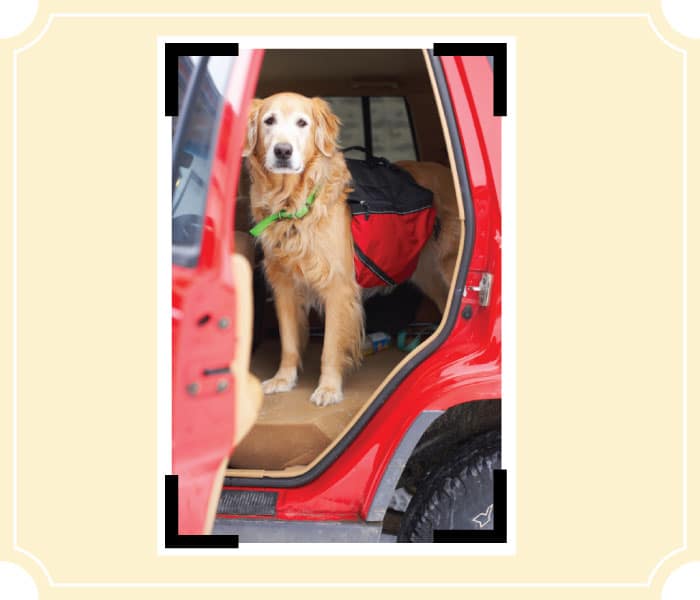Identification, Identification, Identification

- Bowls for water/food
- Can opener for canned food
- Cleanup bags
- Crate or seatbelt restraint system for car travel
- Flight kennels for air travel
- Dog food (make sure if your pet is on a special diet that you bring extra food with you in case you can’t find it in stores at your destination)
- Heartworm pills and other prescribed medications
- Identification tags should be on your pet at all times
- Plastic jug of water for your pet to avoid possible upset stomach the first day (water in new areas may contain minerals or bacteria that a pet needs time to adjust to)
- Ramp for senior dog or one with joint problems
- Towels for muddy paws or a wet dog coming in from the rain/snow
- Treats and toys
- Your pet’s registration and proof of rabies certificate, current photo of your pet
- Your Veternarian’s telephone number (in case you forget required medications)
- First Aid kit in case of an emergency
- Leashes/collars
How many times have you said “Gee I’d love to take my pet but the hotel won’t let me” or “I don’t know what I need when traveling with my pet.” The information contained in this section will provide you with resources for accomodations that allow animals and what things you need to know when traveling with your pet.
We recommend several safety precautions when planning air travel for your pet. Always make sure you have your pet checked out by your veterinarian prior to any trip to make sure your pet is in good health.
- It is recommended that you obtain a health certificate from your veterinarian within 10 days of departure.
- Always make sure your pet is wearing proper identification
- Make sure your pet’s identification collars and/or tags include destination information in case your pet escapes.
- Whenever possible try to book a direct flight. This will minimize the chances of your pet being left on the tarmac during extreme weather conditions or from being mishandled by baggage personnel.
- Purchase a USDA-approved airline shipping crate for your pet. This crate should be large enough for your pet to stand, sit and change positions comfortably. These crates can be purchased from many pet supply stores and airlines.
- Identify – in large bold letters – “LIVE ANIMAL” on the top of the crate and on the sides. Use arrows to identify which side is the upright position of the crate.
- Write your name, address, and telephone number(s) of your pet’s destination point, whether you are traveling with them or someone else is picking up the animal.
- Secure a photograph of your pet to the top of the crate for identification purposes if the animal should escape from the crate. A laminated photo works best and can be taped to the top of the crate. Additionally, you should carry a photograph of your pet.
- Make sure to line the crate with some type of bedding such as shredded paper, towels or newspaper to absorb accidents.
- Freeze water for your pet so that it will not spill during loading but will melt by the time the animal is thirsty.
- Do not lock the door of the crate. Make sure it is securely closed, but not locked, so that airline personnel can open it in case of an emergency.
- Tape a small pouch (cloth is suggested) of dried food outside the crate. This enables airline personnel to feed your pet in case it gets hungry on long-distance flights or a layover.
- Tranquilizing your pet is not generally recommended as it could hamper their breathing. Check with your veterinarian first.
- Make sure to advise all airline employees you encounter, on the ground and in the air, that you are traveling with a pet in the cargo hold so that any additional considerations or attention can be provided. If the plane is delayed, or you have any concerns about the welfare of your pet, insist that airline personnel check the animal when feasible. In some situations removing the animal from the cargo hold and deplaning may be warranted.
- Be proactive in monitoring the welfare of your pet. Ask to watch your pet being loaded on and off the plane. Keep a watchful eye on your animal during unavoidable layovers, particularly if the weather is extremely hot or cold. Your active involvement could mean the difference between life or death for your pet.
- Fly only with major airlines or reputable pet transportation companies.
- Travel early in the morning or evening when the temperatures are less extreme.
- If your pet weighs under 15 pounds it might be able to travel as carry-on luggage. Check with the airline for weight restrictions.
- Confirm both you and your pet’s reservation one day before your flight.
Finding a hotel, motel, bed & breakfast, camp grounds, etc. is as easy as 1-2-3. There are many great books that offer a wide variety of accommodations for you and your companion. Additionally, the internet offers good resources for pet friendly accommodations. Listed below are some of the animals’ picks:
